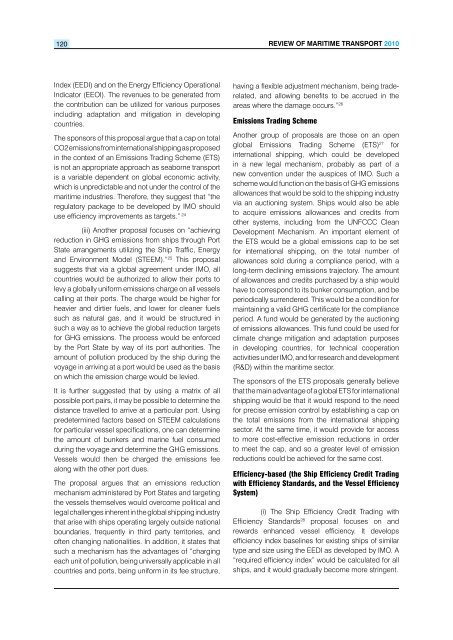Review of Maritime Transport 2010 - Unctad
Review of Maritime Transport 2010 - Unctad
Review of Maritime Transport 2010 - Unctad
You also want an ePaper? Increase the reach of your titles
YUMPU automatically turns print PDFs into web optimized ePapers that Google loves.
120<br />
Index (EEDI) and on the Energy Efficiency Operational<br />
Indicator (EEOI). The revenues to be generated from<br />
the contribution can be utilized for various purposes<br />
including adaptation and mitigation in developing<br />
countries.<br />
The sponsors <strong>of</strong> this proposal argue that a cap on total<br />
CO2 emissions from international shipping as proposed<br />
in the context <strong>of</strong> an Emissions Trading Scheme (ETS)<br />
is not an appropriate approach as seaborne transport<br />
is a variable dependent on global economic activity,<br />
which is unpredictable and not under the control <strong>of</strong> the<br />
maritime industries. Therefore, they suggest that “the<br />
regulatory package to be developed by IMO should<br />
use efficiency improvements as targets.” 24<br />
(iii) Another proposal focuses on “achieving<br />
reduction in GHG emissions from ships through Port<br />
State arrangements utilizing the Ship Traffic, Energy<br />
and Environment Model (STEEM).” 25 This proposal<br />
suggests that via a global agreement under IMO, all<br />
countries would be authorized to allow their ports to<br />
levy a globally uniform emissions charge on all vessels<br />
calling at their ports. The charge would be higher for<br />
heavier and dirtier fuels, and lower for cleaner fuels<br />
such as natural gas, and it would be structured in<br />
such a way as to achieve the global reduction targets<br />
for GHG emissions. The process would be enforced<br />
by the Port State by way <strong>of</strong> its port authorities. The<br />
amount <strong>of</strong> pollution produced by the ship during the<br />
voyage in arriving at a port would be used as the basis<br />
on which the emission charge would be levied.<br />
It is further suggested that by using a matrix <strong>of</strong> all<br />
possible port pairs, it may be possible to determine the<br />
distance travelled to arrive at a particular port. Using<br />
predetermined factors based on STEEM calculations<br />
for particular vessel specifications, one can determine<br />
the amount <strong>of</strong> bunkers and marine fuel consumed<br />
during the voyage and determine the GHG emissions.<br />
Vessels would then be charged the emissions fee<br />
along with the other port dues.<br />
The proposal argues that an emissions reduction<br />
mechanism administered by Port States and targeting<br />
the vessels themselves would overcome political and<br />
legal challenges inherent in the global shipping industry<br />
that arise with ships operating largely outside national<br />
boundaries, frequently in third party territories, and<br />
<strong>of</strong>ten changing nationalities. In addition, it states that<br />
such a mechanism has the advantages <strong>of</strong> “charging<br />
each unit <strong>of</strong> pollution, being universally applicable in all<br />
countries and ports, being uniform in its fee structure,<br />
<strong>Review</strong> <strong>of</strong> MaRitiMe tRanspoRt <strong>2010</strong><br />
having a flexible adjustment mechanism, being traderelated,<br />
and allowing benefits to be accrued in the<br />
areas where the damage occurs.” 26<br />
Emissions Trading Scheme<br />
Another group <strong>of</strong> proposals are those on an open<br />
global Emissions Trading Scheme (ETS) 27 for<br />
international shipping, which could be developed<br />
in a new legal mechanism, probably as part <strong>of</strong> a<br />
new convention under the auspices <strong>of</strong> IMO. Such a<br />
scheme would function on the basis <strong>of</strong> GHG emissions<br />
allowances that would be sold to the shipping industry<br />
via an auctioning system. Ships would also be able<br />
to acquire emissions allowances and credits from<br />
other systems, including from the UNFCCC Clean<br />
Development Mechanism. An important element <strong>of</strong><br />
the ETS would be a global emissions cap to be set<br />
for international shipping, on the total number <strong>of</strong><br />
allowances sold during a compliance period, with a<br />
long-term declining emissions trajectory. The amount<br />
<strong>of</strong> allowances and credits purchased by a ship would<br />
have to correspond to its bunker consumption, and be<br />
periodically surrendered. This would be a condition for<br />
maintaining a valid GHG certificate for the compliance<br />
period. A fund would be generated by the auctioning<br />
<strong>of</strong> emissions allowances. This fund could be used for<br />
climate change mitigation and adaptation purposes<br />
in developing countries, for technical cooperation<br />
activities under IMO, and for research and development<br />
(R&D) within the maritime sector.<br />
The sponsors <strong>of</strong> the ETS proposals generally believe<br />
that the main advantage <strong>of</strong> a global ETS for international<br />
shipping would be that it would respond to the need<br />
for precise emission control by establishing a cap on<br />
the total emissions from the international shipping<br />
sector. At the same time, it would provide for access<br />
to more cost-effective emission reductions in order<br />
to meet the cap, and so a greater level <strong>of</strong> emission<br />
reductions could be achieved for the same cost.<br />
Efficiency-based (the Ship Efficiency Credit Trading<br />
with Efficiency Standards, and the Vessel Efficiency<br />
System)<br />
(i) The Ship Efficiency Credit Trading with<br />
Efficiency Standards 28 proposal focuses on and<br />
rewards enhanced vessel efficiency. It develops<br />
efficiency index baselines for existing ships <strong>of</strong> similar<br />
type and size using the EEDI as developed by IMO. A<br />
“required efficiency index” would be calculated for all<br />
ships, and it would gradually become more stringent.

















